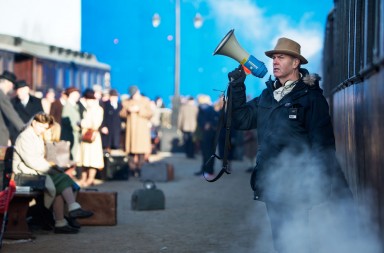Oslo City Hall (Rådhuset) houses the city council and the administration of Oslo. The interiors of Oslo City Hall were decorated by famous Norwegian artists: Per Krohg, Axel Revold, Alf Rolfsen, Dagfin Werenskiold… It is also the place where the Nobel Peace Prize ceremony is presented every year on December 10.
Oslo’s Structure of the Century—an attraction that surprises
The Oslo City Hall is the city’s administrative body and the seat of the City Council. It is situated in Pipervika in central downtown Oslo. The area was completely renovated and rebuilt to make room for the new city hall back in the late 1920s. From the drawing board, it took thirty years for the plan to be realised, with a brief pause in construction on the outbreak of World War II. In 1950, the Oslo City Hall, designed in the Functionalism architectural style, was completed and officially inaugurated on 15 May 1950. At first glance, the city hall might disappoint. The building stands out from the rest of Oslo’s sleek, modern Scandinavian architecture, with its solid brown brick construction, heavy textiles, and blunt corners. Nevertheless, in 2005, “Rådhuset” was dubbed Oslo’s “Structure of the Century”.
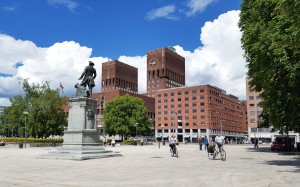
Functionalism is the architectural style of Oslo City Hall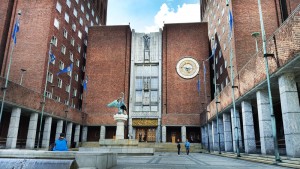
At a closer look, City Hall is much more than just the brick-clad ensemble of cubes it exhibits from a distance. The building is a storybook of Norway’s history and culture, and these historic tales unfold along the art-packed corridors leading to the main entrance.
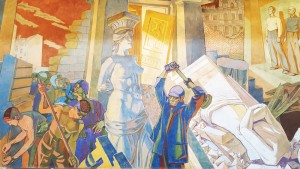
These massive murals on the first floor of Oslo City Hall illustrate the history of Norway of the first part of the 20th century.
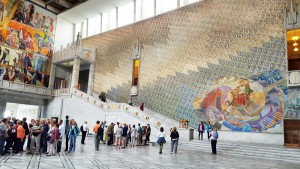
In this hall, the Nobel Peace Prize ceremony is held annually on December 10.
The main hall was decorated by two famous Norwegian artists: Henrik Sørensen and Alf Rolfsen. In one of the frescoes, the pillars of Norwegian identity are represented—fishing, forestry, and industry—flanked on either end by explorer Fridtjof Nansen and playwright Bjørnstjerne Bjørnson, both of whom won Nobel prizes. The mural on the east side of the wall displays the history of the Nazi occupation.
On the second floor, guests will find hidden treasures like the “Munch room” and “Festgalleriet” (the Ceremonial Gallery), which is sumptuously decorated with tapestries and scenes from Norwegian history, including paintings of King Harald V and his Queen Sonja, King Olav V, and King Haakon VII.
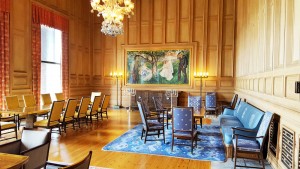
The Munch Room with his painting ‘Life’ adorning the back wall.
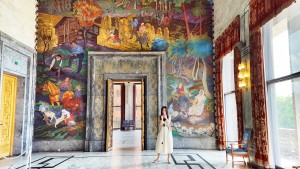
On the way to the Banquet Hall.
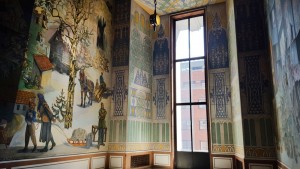
Magnificent murals on the second floor of Oslo City Hall by Per Krohg (1889-1965), the Norwegian artist.
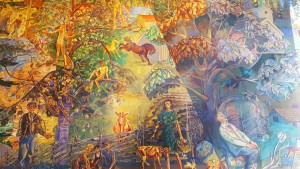
Magnificent murals on the second floor of Oslo City Hall by Per Krohg (1889-1965), the Norwegian artist.
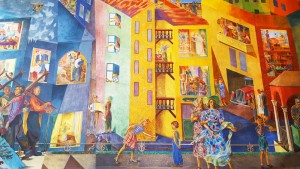
Magnificent murals on the second floor of Oslo City Hall by Per Krohg (1889-1965), the Norwegian artist.
The Story of St Hallvard, the patron saint of Oslo
The city hall also tells the tale of St. Hallvard, the patron of Oslo. According to legend, Hallvard was the son of a rich nobleman. One day, a pregnant starving woman stole food from the market, and when the merchants gave chase to execute her she ran to Hallvard for help. He carried her away in his boat, but the men followed and shot him with three arrows. When they got close enough to realise who they had killed, they panicked and hung a millstone around Hallvard’s neck, then threw him in the ocean. But the next day, he floated back up, despite the millstone still attached. Other miracles ensued, and soon Hallvard was canonised as the patron saint of Oslo in 1073.
Oslo’s patron is a frequent theme in the scene of the city. There’s a St. Hallvard craft brewery, ever since 1956 the Mayor of Oslo has awarded the St. Hallvard Medal for meritorious service, he is honoured in the city coat of arms, has his own sculpture on the sea side of the city hall, and is even displayed on all the manholes in Norway’s capital.
The Wooden Friezes of Oslo City Hall
There are 16 wooden friezes in the City Hall’s courtyard made by Dagfin Werenskiold (1892-1977), painter and sculptor. They show the motifs from Norse mythology: the life of gods and the stories of wisdom and love, war and hate, and magnificent visions of the future.
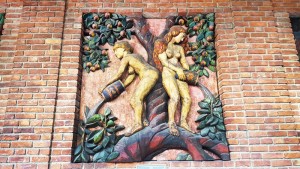
This frieze is about the Goddesses of Destiny. They water the world tree’s leaves (or the holy tree – Yggdrasil) each day with spray water from the flood. From this comes the dew that falls in the valleys, and this is why the holy tree remains evergreen…
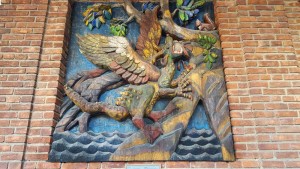
This is Nidhogg – a dragon-like, serpent beast who gnaws and tears at the third root of the ash Yggdrasil, the holy tree. Ygdrasil has roots that spread in three directions: one leads to the giant Mime’s well, the source of recollection. Here everything that has ever happened is reflected, and the Mime’s well is, therefore, full of wisdom. There rests Odin’s eye pawned so that he may drink of the fountain of Mime. Another root leads to the Well of Urd, whilst the third goes down to Kvergjelmir in Nivlheim (the underworld, kingdom of the dead), where Nidhogg commits his fearful deed.
The Sculptures of Oslo City Hall
Pipervika, a neighborhood in the borough Sentrum in Oslo, where now Oslo City Hall is located. It was the area where prostitutes used to sell their services in the Victorian times. There were many of them there as it was very hard to find a job for a poor woman back then. This sculpture on the wall of Oslo City Hall shows a prostitute with her pimp on the left and a rich man (a client) on the right.
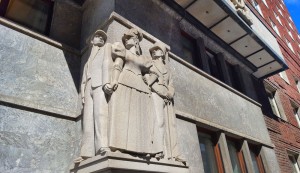
The scene from Victorian times: a prostitute, her pimp and a rich client in a street of the Pipervika neighbourhood – the area where later in the middle of the 20th century Oslo City Hall was erected.
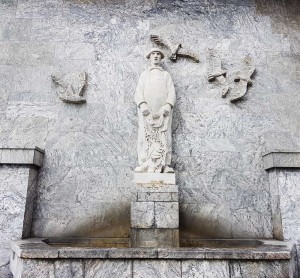
A tribute to Norwegian fishermen.
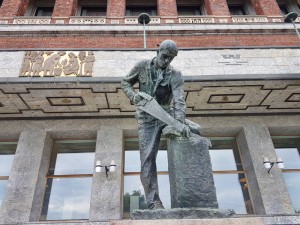
Norwegians celebrate their working class: one of the sculptures by the entrance of the southern side of Oslo City Hall.
The Roof of The Eastern Tower of Oslo City Hall
The roof of the eastern tower has a 49-bell carillon which plays every hour. It has long been a traditional part of daily life in the Norwegian capital, chiming on the quarter-hour and even playing the occasional concert. A carillon concert is held in the east tower every Sunday during the summer. Those who wish to visit the carillon can meet up at the sign of summer guiding inside City Hall at 14:45 on Sundays. The largest bell weighs 4000 kg and carries the city of Oslo’s logo with the patron saint Hallvard and the motto of the city: “Unanimiter et constanter” (Latin: united and constant).
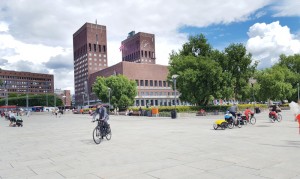
Norwegians (just like Dutch) have a great passion for bicycles!
Visit Oslo City Hall
Book your guided tour (for up to 30 persons) via email or phone: postmottak@rft.oslo.kommune.no / +4723461200. There are free guided tours during the whole summer: at 10AM, noon and at 2 PM.
Free Admission: You can also come on your own (without a guide) to Oslo City Hall and experience the art and history from 9 a.m. to 4 p.m. The entrance is free!
City Hall is located in the heart of Oslo and is easily accessible by foot and public transportation.
Bus stop: Rådhuset, takes you directly to City Hall.
Tram stop: Aker Brygge, with only a 5-minute walk to City Hall.
Metro stop: Nationalteatret, with a 5-minute walk.
If you wish to learn more about Oslo, book a professional guide at Oslo Guidebureau. Phone: +4722422818.

Text: Stefanie Tuma, Oslo Guidebureau / Photos&Video: Dina Johnsen, TheOsloBook.no


